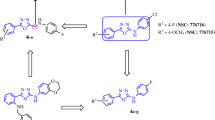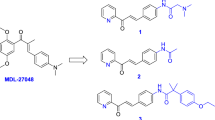Abstract
Monomethyl auristatin F (MMAF), a synthetic analogue of the natural compound dolastatin 10, has garnered significant attention in cancer research due to its high potency in vitro. While previous studies have focused on modifying the N-terminal extension of the amino group and the C-terminal modification of the carboxyl group, there has been limited exploration into modifying the P1 and P5 side chains. In this study, we substituted the valine residue at the P1 position with various natural or unnatural amino acids and introduced triazole functional groups at the P5 side chain. Compounds 11k and 18d exhibited excellent inhibition on tubulin. Additionally, compound 18d demonstrated enhanced cytotoxicity against HCT116 cells compared to the parent compound MMAF, suggesting its potential as a cytotoxic payload for further antibody–drug conjugates (ADCs) development.
Graphical abstract







Similar content being viewed by others
References
Jin Y, Schladetsch MA, Huang X et al (2021) Stepping forward in antibody-drug conjugate development. Pharmacol Ther 229:107917. https://doi.org/10.1016/j.pharmthera.2021.107917
Abdolvahab MH, Karimi P, Mohajeri N et al (2024) Targeted drug delivery using nanobodies to deliver effective molecules to breast cancer cells: the most attractive application of nanobodies. Cancer Cell Int 24:67. https://doi.org/10.1186/s12935-024-03259-8
Sun T, Niu X, He Q et al (2023) Development, efficacy and side effects of antibody-drug conjugates for cancer therapy (Review). Mol Clin Oncol 18:47. https://doi.org/10.3892/mco.2023.2643
Wang Z, Li H, Gou L et al (2023) Antibody–drug conjugates: recent advances in payloads. Acta Pharm Sin B 13:4025. https://doi.org/10.1016/j.apsb.2023.06.015
Wainberg ZA, Hochster HS, Kim EJ et al (2020) Open-label, phase I study of nivolumab combined with nab-paclitaxel plus gemcitabine in advanced pancreatic cancer. Clin Cancer Res 26:4814. https://doi.org/10.1158/1078-0432.CCR-20-0099
Philip PA, Lacy J, Portales F et al (2020) Nab-paclitaxel plus gemcitabine in patients with locally advanced pancreatic cancer (LAPACT): a multicentre, open-label phase 2 study. Lancet Gastroenterol Hepatol 3:285. https://doi.org/10.1016/s2468-1253(19)30327-9
Ko AH, Truong T-G, Kantoff E et al (2012) A phase I trial of nab-paclitaxel, gemcitabine, and capecitabine for metastatic pancreatic cancer. Cancer Chemother Pharmacol 70:875. https://doi.org/10.1007/s00280-012-1979-7
Zhang D, Benedikt Westphalen C, Quante M et al (2024) Gemcitabine and nab-paclitaxel combined with afatinib in metastatic pancreatic cancer—results of a phase 1b clinical trial. Eur J Cancer 201:113926. https://doi.org/10.1016/j.ejca.2024.113926
Rittmeyer A, Barlesi F, Waterkamp DA et al (2017) Atezolizumab versus docetaxel in patients with previously treated non-small-cell lung cancer (OAK): a phase 3, open-label, multicentre randomised controlled trial. Lancet 389:255. https://doi.org/10.1016/s0140-6736(16)32517-x
Herbst RS, Baas P, Kim D-W et al (2016) Pembrolizumab versus docetaxel for previously treated, PD-L1-positive, advanced non-small-cell lung cancer (KEYNOTE-010): a randomised controlled trial. Lancet 387:1540. https://doi.org/10.1016/s0140-6736(15)01281-7
Borghaei H, Paz-Ares LG, Horn L et al (2015) Nivolumab versus docetaxel in advanced nonsquamous non-small-cell lung cancer. N Engl J Med 373:1627. https://doi.org/10.1056/nejmoa1507643
Qu Y, Safonova OV, De Luca V (2018) Completion of the canonical pathway for assembly of anticancer drugs vincristine/vinblastine in Catharanthus roseus. Plant J 97:257. https://doi.org/10.1111/tpj.14111
Geisler SM, Doan RA, Cheng GC et al (2019) Vincristine and bortezomib use distinct upstream mechanisms to activate a common SARM1-dependent axon degeneration program. JCI insight 4:129920. https://doi.org/10.1172/jci.insight.129920
Škubník J, Pavlíčková VS, Ruml T et al (2021) Vincristine in combination therapy of cancer: emerging trends in clinics. Biology 10:849. https://doi.org/10.3390/biology10090849
Bai R, Petit GR, Hamel E (1941) Dolastatin 10, a powerful cytostatic peptide derived from a marine animal: inhibition of tubulin polymerization mediated through the vinca alkaloid binding domain. Biochem Pharmacol 1990:39. https://doi.org/10.1016/0006-2952(90)90613-p
Pettit GR, Kamano Y, Herald CL et al (1987) The isolation and structure of a remarkable marine animal antineoplastic constituent: dolastatin 10. J Am Chem Soc 109:6883. https://doi.org/10.1021/ja00256a070
Hamel E (1992) Natural products which interact with tubulin in the vinca domain: maytansine, rhizoxin, phomopsin a, dolastatins 10 and 15 and halichondrin B. Pharmacol Ther 55:31. https://doi.org/10.1016/0163-7258(92)90028-x
Lonial S, Lee HC, Badros A et al (2020) Belantamab mafodotin for relapsed or refractory multiple myeloma (DREAMM-2): a two-arm, randomised, open-label, phase 2 study. Lancet Oncol 21:207. https://doi.org/10.1016/S1470-2045(19)30788-0
Markham A (2020) Belantamab Mafodotin: first approval. Drugs 80:1607. https://doi.org/10.1007/s40265-020-01404-x
Chang HL, Schwettmann B, McArthur HL et al (2023) Antibody-drug conjugates in breast cancer: overcoming resistance and boosting immune response. J Clin Investig 133:172156. https://doi.org/10.1172/jci172156
Yamazaki CM, Yamaguchi A, Anami Y et al (2020) Antibody-drug conjugates with dual payloads for combating breast tumor heterogeneity and drug resistance. Nat Commun 12:3528. https://doi.org/10.1038/s41467-021-23793-7
Abelman RO, Wu B, Spring LM et al (2023) Mechanisms of resistance to antibody-drug conjugates. Cancers 24:9674. https://doi.org/10.3390/ijms24119674
Tsuchikama K, Anami Y, Ha SYY et al (2024) Exploring the next generation of antibody-drug conjugates. Nat Rev Clin Oncol 21:203. https://doi.org/10.1038/s41571-023-00850-2
Mendelsohn BA et al (2017) Investigation of hydrophilic auristatin derivatives for use in antibody drug conjugates. Bioconjug Chem 28:371. https://doi.org/10.1021/acs.bioconjchem.6b00530
Yan Q, Wang Y, Zhang W, Li Y (2016) Novel azetidine-containing TZT-1027 analogues as antitumor agents. Mar Drugs 14:85. https://doi.org/10.3390/md14050085
Dugal-Tessier J, Barnscher SD, Kanai A, Mendelsohn BA (2017) Synthesis and evaluation of dolastatin 10 analogues containing heteroatoms on the amino acid side chains. J Nat Prod 80:2484. https://doi.org/10.1021/acs.jnatprod.7b00359
Doronina SO et al (2006) Enhanced activity of monomethylauristatin F through monoclonal antibody delivery: effects of linker technology on efficacy and toxicity. Bioconjug Chem 17:114–124. https://doi.org/10.1021/bc0502917
Moquist PN et al (2024) Abstract 4476: Novel auristatins with improved tolerability and unique bystander activity profile. Can Res 84:4476–4476. https://doi.org/10.1158/1538-7445.AM2024-4476
Komarova Y, Waight AB, Bargsten K et al (2016) Structural basis of microtubule destabilization by potent auristatin anti-mitotics. PLoS ONE 11:160890. https://doi.org/10.1371/journal.pone.0160890
Maderna A, Doroski M, Subramanyam C et al (2014) Discovery of cytotoxic dolastatin 10 analogues with N-terminal modifications. J Med Chem 57:10527. https://doi.org/10.1021/jm501649k
Tomioka K, Kanai M, Koga K (1991) An expeditious synthesis of dolastatin 10. Tetrahedron Lett 32:2395. https://doi.org/10.1186/s12934-018-1036-2
Shioiri T, Hayashi K, Hamada Y (1913) Stereoselective synthesis of dolastatin 10 and its congeners. Tetrahedron 1993:49. https://doi.org/10.1016/S0040-4020(01)80547-0
Zhou W, Nie X-D, Zhang Y et al (2017) A practical approach to asymmetric synthesis of dolastatin 10. Org Biomol Chem 15:6119. https://doi.org/10.1039/C7OB01395G
Mordant C, Reymond S, Tone H et al (2007) Total synthesis of dolastatin 10 through ruthenium-catalyzed asymmetric hydrogenations. Tetrahedron 63:6115. https://doi.org/10.1016/j.tet.2007.03.036
Acknowledgements
Support for this research from the National Natural Science Foundation of China (92056201), the National Key Research and Development Program of China (2023YFC3404500), Guangdong Provincial Key Laboratory of Chiral Molecule and Drug Discovery (2023B1212060022), Southern Marine Science and Engineering Guangdong Laboratory (Zhuhai) (SML2003SP236), Natural Science Foundation of Guangdong Province (2023A1515011486) and Key-Area Research and Development Program of Guangdong Province (2022B1111050003) is greatly acknowledged.
Author information
Authors and Affiliations
Contributions
LSY and LZ performed experiments on synthesis, LSY analyzed the data and performed cell viability evaluation of the target compounds, XLL carried out experiments on Tubulin polymerization assay, WHH and YQ designed the study, supervised the study and revised the manuscript.
Corresponding authors
Ethics declarations
Conflict of interest
The authors declare no conflict of interest.
Additional information
Publisher's Note
Springer Nature remains neutral with regard to jurisdictional claims in published maps and institutional affiliations.
Supplementary Information
Below is the link to the electronic supplementary material.
Rights and permissions
Springer Nature or its licensor (e.g. a society or other partner) holds exclusive rights to this article under a publishing agreement with the author(s) or other rightsholder(s); author self-archiving of the accepted manuscript version of this article is solely governed by the terms of such publishing agreement and applicable law.
About this article
Cite this article
Yang, L., Li, X., Zhao, L. et al. Design, synthesis and bioactivity evaluation of novel monomethyl auristatin F analogues. Mol Divers (2024). https://doi.org/10.1007/s11030-024-10873-1
Received:
Accepted:
Published:
DOI: https://doi.org/10.1007/s11030-024-10873-1




